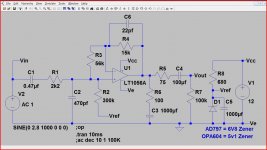Okay, a couple of interesting areas in the files:
Here we see what seems to be like a step difference occurring:
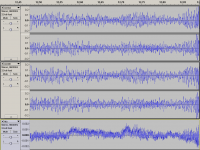
Zoom in, and this is what it looks like - note the timeline on the top of the images:
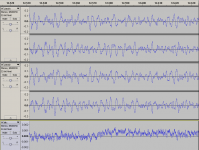
And at another spot, the difference file suddenly gains much greater amplitude, and takes a while to settle down::
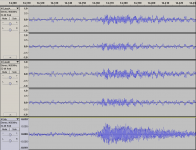
and zooming in:
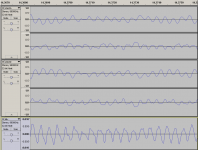
For me, differences are audible - and this is showing significant real variations in the waveforms.
Here we see what seems to be like a step difference occurring:

Zoom in, and this is what it looks like - note the timeline on the top of the images:

And at another spot, the difference file suddenly gains much greater amplitude, and takes a while to settle down::

and zooming in:

For me, differences are audible - and this is showing significant real variations in the waveforms.
Last edited:
Here are the differences btn the four files.
(Audio DiffMaker SW does the time alignment, gain alignment, compensation for sample rate drift and then subtracts one file from the other. Resulting wave files have very low sound level. Turn up the volume during playback).
Thanks
Just tried listening on headphones with PC volume up full. Most obvious feature is hiss in all but B-B. All the others have faintly detectable music (very very faint) together with some artifact (again faint) that is heard in the first few seconds on all. Hard to describe that one.
The peak level on all your images seems to be around -84 db, very low indeed.
Not a rethink, just trying to present my findings in a way to make sense - which ending up not making sense !!
I'll try again ...
Ltest1 = Better Loaded.
Ltest2 = Poorer Loaded.
Ltest3 = Poorer Unloaded.
Ltest4 = Better Unloaded.
LtestA = Better Unloaded.
LtestB = Poorer Unloaded.
LtestC = Better Loaded.
LtestD = Poorer Loaded.
These are all identical results, just presented in different formats!
The LT1 samples for me were very distinctively different, I had a harder time with LT2, my setup was a bit dodgy, and the piano was provoking the speakers to misbehave, I'm getting some rubbing noises at times.
Interestingly, the OPA604, unloaded, for my setup, presented SY's recording to best advantage, by quite a margin - purely a coincidence, experimental error, or ... ?
Edit: To my ears, what I called the "better" samples made the tonal qualities of what I was hearing more distinctive, allowed me to discriminate more easily the details, in sound terms, of what was happening. In particular, the individual qualities of the voice, and the guitar, in LT1 were separated, were distinct sound elements; in the "poorer" these tonal qualities were homogenised, as if they had gone through a sound blender so to speak.
Its no real surprise that you liked the OPA604, its one I often recommend on here together with the proviso that it can sound "the most coloured but in a good way". That you liked it (and more importantly seemed able to identify it) fits in with your previous preferences in past tests.
In the piano test (LT2) if you look back at the key then LtestA was the OPA604 loaded and LtestD the OPA604 unloaded.
Sorry Mooly, Impossible for me to download your files: I'm a fresh (2Days) emigrate in Portugal, and i have no Internet in my new house for the moment.
Just my French phone card, limited in datas.
I'll keep the Dropbox files available for quite some time and then anyone can come back to try them.
Both Douglas Self and Samuel Groner measured the OPA604. Here are comments by Samuel Groner:
SG-Acoustics · Samuel Groner · IC OpAmps
opamp_distortion.pdf file
We have tested this opamp, about 13 years ago, for sound. Some people liked it, but it definitely did not sound accurate.
Why the manufacturer advertises this opamp as having particularly low distortion remains somewhat mysterious, all four distortion mechanism are heavily present, and the distortion at higher frequencies rapidly increases even further although the slew-rate of the amplifier is high. At least higher supply voltage helps things considerably.
SG-Acoustics · Samuel Groner · IC OpAmps
opamp_distortion.pdf file
We have tested this opamp, about 13 years ago, for sound. Some people liked it, but it definitely did not sound accurate.
In my view, OPA604/2694 tries too hard to sound warm and cuddly. On first listening, it appears very likeable, but after a few hours' worth of listening, one realizes that it is not very accurate, even if mostly pleasanetly so.
Some love it, for example, Milan Karan of Karan Acoustics swears by it. I don't mind it, but my goal is accuracy, not warmth, and as such, it is not my dream op amp. Frankly, I was happier with the auncient LF 356 overall, especially when a simple current booster was added. Hardly perfect, to be sure, but in my view, nearer to accuracy.
Originally, out of the box, my Yamaha CDX 993 CD player was like that. The problem lay with the NJR op amp acting as the I/V converter, and replacing it with an AD 826 op amp cured the problem, leaving the warmth and cuddlieness, but delivering more detail.
Some love it, for example, Milan Karan of Karan Acoustics swears by it. I don't mind it, but my goal is accuracy, not warmth, and as such, it is not my dream op amp. Frankly, I was happier with the auncient LF 356 overall, especially when a simple current booster was added. Hardly perfect, to be sure, but in my view, nearer to accuracy.
Originally, out of the box, my Yamaha CDX 993 CD player was like that. The problem lay with the NJR op amp acting as the I/V converter, and replacing it with an AD 826 op amp cured the problem, leaving the warmth and cuddlieness, but delivering more detail.
Last edited:
this opamp
Noticed how freaky the phase/frequency curve of the OPA604 looks ?
Mooly, can you please post your AD797 test circuit?
Thanks...
Here you go. Its very similar to the earlier one, just detail differences to get the best from both devices while keeping the basic circuit the same between the two,
Attachments
.......... We have tested this opamp, about 13 years ago, for sound. Some people liked it, but it definitely did not sound accurate...........
I've studied Samuels results many times in the past. Interesting reading.
In my view, OPA604/2694 tries too hard to sound warm and cuddly. On first listening, it appears very likeable, but after a few hours' worth of listening, one realizes that it is not very accurate, even if mostly pleasanetly so.
Some love it, for example, Milan Karan of Karan Acoustics swears by it.............
OK... so if you accept that folk sometimes have a definite preference for a "certain type of sound", and if you were a manufacturer or circuit designer, would you consider developing amplifiers and circuitry that a (perhaps) quite large listening percentage of potential customers actually liked and would pay money to buy or would you ignore that potential market on the basis that the customer was wrong in their belief and preference.
Its an interesting thought... you all probably base decisions on most other things with at least a little "subjectivity" and and quite a lot of "I quite like that one rather than this one" rather than basing the decision on pure technical correctness in some area.
Mooly,
Thanks for posting the circuit. Why R3? Not behind my regular computer so have to head-sim it, but wouldn't this increase the noise gain of the setup, thus increasing distortion? Another thing I don 't quite get is why to put the Vref above nominal ground. There must be reasons I don't quite grasp, so please explain.
Thanks for posting the circuit. Why R3? Not behind my regular computer so have to head-sim it, but wouldn't this increase the noise gain of the setup, thus increasing distortion? Another thing I don 't quite get is why to put the Vref above nominal ground. There must be reasons I don't quite grasp, so please explain.
In my view, OPA604/2694 tries too hard to sound warm and cuddly. On first listening, it appears very likeable, but after a few hours' worth of listening, one realizes that it is not very accurate, even if mostly pleasanetly so.
Very well said, Dejan.
Mooly,
Thanks for posting the circuit. Why R3? Not behind my regular computer so have to head-sim it, but wouldn't this increase the noise gain of the setup, thus increasing distortion? Another thing I don 't quite get is why to put the Vref above nominal ground. There must be reasons I don't quite grasp, so please explain.
Yes it does increase the noise gain but can bring benefit by bringing the opamp away from the edge of instability. Its a tenuous argument, the logic being that in order for a high performance opamp to be quoted as unity gain stable and yet still have really good performance, some opamps are running right on the ragged edge when used with 100% feedback. This technique throws a little open loop gain away and ensures stability.
It would be interesting to hear John and Pavels thoughts on that. I know its a technique favoured by Nelson Pass.
Vref is needed because the opamp was run on a single rail. Its just a stable bias voltage, altered slightly between devices to get the max voltage swing into 100 ohms.
if you accept that folk sometimes have a definite preference for a "certain type of sound", and if you were a manufacturer or circuit designer, would you consider developing amplifiers and circuitry that a (perhaps) quite large listening percentage of potential customers actually liked and would pay money to buy or would you ignore that potential market on the basis that the customer was wrong in their belief and preference.
IMO, everyone "prefers" low order distortion. But that's in comparison to other types of distortion. If the comparison is between high (low order) distortion versus low (general) distortion, most probably the low distortion will win. So there exist a balanced approach where distortion is made SLIGHTLY higher but with dominant low order distortion. So we have to pay attention to the spectrum of the distortion. (I believe that the spectrum is only a visual byproduct).
So it is not fair/right to think that you either like the distortion or you don't (Because I like the distortion but I don't like it).
Here are some examples:
(1) OPA134 is sweet. I like it. But not if compared to much lower distortion opamps. (But of course, distortion is not the only thing to consider).
(2) VIFA XT25 is sweet. I like it because it was cheap. Very preferable for its price but I'm playing beyond its league so will never consider using it in my main systems (due to the distortion).
(3) Tube amp is sweet. I like it and it has been very hard (took years) to find solid state amp that is comparably preferable. But once you "found" it, you will know that distortion IS distortion.
Thanks Mooly, it is not the way I would do it, so interested to hear what others have to say about it. Nelson Pass apparently likes to flavor his amplification devices with a pinch of distortion, so that might be why he is using this kind of setup.
For the AD797 in unity gain I would follow the spec sheet advice, haven't worked with the OPA604 and don't intend to, so who knows. The ground symbol had thrown me off, so overlooked that you were running from a single supply rail.
For the AD797 in unity gain I would follow the spec sheet advice, haven't worked with the OPA604 and don't intend to, so who knows. The ground symbol had thrown me off, so overlooked that you were running from a single supply rail.
Fair comment 
At the end of the day though, we all either have to put our knowledge and experience together to make something that pleases the listener (you and me) or else buy a product based on listening tests (which many do of course) or else buy or build what could really be classed as an instrumentation amp where the aim is signal in = signal out with as little change as possible to the structure of that applied signal.
All valid approaches. Ultimately the final product has to please the end user, and what they want from it isn't always what the designer thinks they want.
At the end of the day though, we all either have to put our knowledge and experience together to make something that pleases the listener (you and me) or else buy a product based on listening tests (which many do of course) or else buy or build what could really be classed as an instrumentation amp where the aim is signal in = signal out with as little change as possible to the structure of that applied signal.
All valid approaches. Ultimately the final product has to please the end user, and what they want from it isn't always what the designer thinks they want.
as little change as possible to the structure of that applied signal.
What/which "structure"?
A girl baby could be so sweet. But to get a sweet lady you need more than just augment it

What/which "structure"?
A girl baby could be so sweet. But to get a sweet lady you need more than just augment it
Structure... as in the signals properties of amplitude vs time. Any change to that can be looked on as distortion, be it amplitude distortions (as in non linear), THD, IM and so on. If what comes out of the amplifier can be differentiated in any way from the original then it can be said to be distorted.
IMO, everyone "prefers" low order distortion. But that's in comparison to other types of distortion. If the comparison is between high (low order) distortion versus low (general) distortion, most probably the low distortion will win. So there exist a balanced approach where distortion is made SLIGHTLY higher but with dominant low order distortion. So we have to pay attention to the spectrum of the distortion. (I believe that the spectrum is only a visual byproduct).
So it is not fair/right to think that you either like the distortion or you don't (Because I like the distortion but I don't like it).
Here are some examples:
(1) OPA134 is sweet. I like it. But not if compared to much lower distortion opamps. (But of course, distortion is not the only thing to consider).
(2) VIFA XT25 is sweet. I like it because it was cheap. Very preferable for its price but I'm playing beyond its league so will never consider using it in my main systems (due to the distortion).
(3) Tube amp is sweet. I like it and it has been very hard (took years) to find solid state amp that is comparably preferable. But once you "found" it, you will know that distortion IS distortion.
That sums it all up. On the one hand you say you "like" some distortion, and yet on the other you know its not right and therefore you don't "like" it as much.
Its like there is some great unwritten rule that says that whatever you do, don't admit to liking something inferior (but by what definition inferior) or something that adds a little colour by way of distortion. You must always go for the more perfect option... and it doesn't matter if secretly you are a little dissatisfied with the result... it has the better numbers therefore it must be me/my system/my records/my CD's that are at fault.
Would the manufacturer or seller of some hi end gear say to a prospective customer "well I'm sorry but unless you partner this amp with this particular source equipment etc.......) then you are wasting your money because all you are hearing is the inferior equipment partnering the "perfect". Of course that doesn't happen. We happily accept comments of changing a cap or whatever and the sonic gains that accompanied it without ever questioning the budget £$2k speakers or £$500 silver spinner.
Just to divert for a second, what about tube aficionados. With solid state we mostly talk of a half of a quarter of a third of nothing and debate it ad infinitum. Have we ever measured a tube preamp to see how distortion is affected by airborne vibration setting up resonances in the plates. It could be very specific at certain frequencies and give a comb effect. No good checking at spot frequencies, it would have to be done I would imagine at very small sub Hz increments. Such an effect would also be non linear with amplitude. However we just "accept" that some like tube amps and their characteristic sound. Because something like that is a bit of an unmeasurable, its swept under the carpet... it doesn't matter... just listen to the fabulous sound of the system as a whole. And that is what it is all about.
Why, when it comes to solid state, can some not accept that some listeners out there choose equipment purely on "how it actually sounds to them"
Mooly, my experience is that the lesser you change the signal, the betterder it sounds. In that sense, a perfect instrumentation amp is good enough for me
I've studied Samuels results many times in the past. Interesting reading.
...
OK... so if you accept that folk sometimes have a definite preference for a "certain type of sound", and if you were a manufacturer or circuit designer, would you consider developing amplifiers and circuitry that a (perhaps) quite large listening percentage of potential customers actually liked and would pay money to buy or would you ignore that potential market on the basis that the customer was wrong in their belief and preference.
Its an interesting thought... you all probably base decisions on most other things with at least a little "subjectivity" and and quite a lot of "I quite like that one rather than this one" rather than basing the decision on pure technical correctness in some area.
No, I would not. But that's just me, I'm sure the new whizz kids would, they'd do anything to keep the shareholders happy.
OP604/2604 did have a rep of a high order about 15 years ago. Whomsoever doubts that, just open up many Scandianvian audio products and you'll see it there. At the time, over there, it was THE LAW!
But of course it doesn't HAVE to be like that. Karan knows how to make it be much more neutral and a bit more detailed than in most other applications.
As I clearly stated, my personal goal is neutrality, which means no specific character of its own, just that of the signal. Impossible in absolute terms, but trying counts. Like what I sometimes manage to squeeze from the old favorite, OP 37; far surpassed by modern op amps, but still one hell of a good op amp.
Beiseds, I stand corrected by my own experinece. I plain hate the sound produced by BB 134 and relatives, it came to that I could identify it in an audio unit, until I purchased my own NAD 565 BEE CD player. Obviously, somebody in NAD took the time and made the effort, producing by far the best implementation of those op amps I have heard thus far - clean, clear, detailed, fast enough, actually I can't find anything to criticize it for.
And this says all I have to say on the subject of op amps. All of them, to the last one, can be made to sound good at least, and often very good, IF one takes the time and trouble to get to know it well. I spent hundreds of hours playing arouind with OP 37 way back, but today, it can't surprise me any more. Just so you know, I did take the trouble of making sure it came from AD as directly as possible, I'm well aware of many copies, mostly useless, coming from mostly China. I always buy as direct from AD as I can manage and am thus spared unpleasant surprises later on.
With all due respect to everyone, while this makes for very interesting reading, I think you are going the worog way about it. You are searching for the Holy Grail The Perefct Op Amp, which like all holy grails is an illusion, it never did and never will exist.
I would suggest you pick out two, perhaps three op amps you like by reading their specs, buy samples and do things with them, from very safe to absolutely ridiculous. Get your own hands-in feeling for them, F-ing around by measuring their THD and IM means diddley regarding how they will actually sound in a well designed circuit. It makes no sense to me to waste time searching for a high current op amps, I prefer to search for a good sounding one, I can always add a discrete current booster, but I have to work to produce one which will have the op amp's sound and the transistors' current capability working in harmony.
Mooly, please understand, this is by no means a critique of your work, just a different approach to the same problem. I believe my appraoch to be more practical, more scalable and definitely more universal, as it's not applicable to a few op amps only.
Last edited:
- Status
- Not open for further replies.
- Home
- Member Areas
- The Lounge
- John Curl's Blowtorch preamplifier part II
